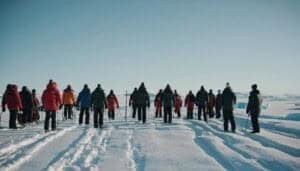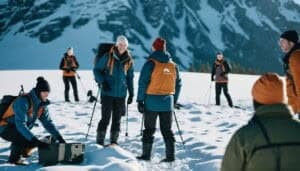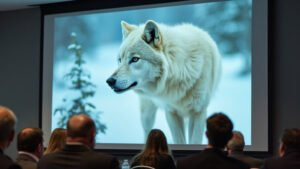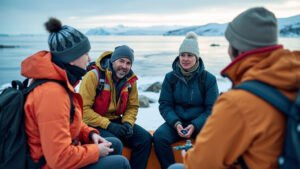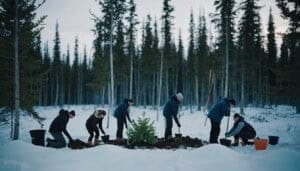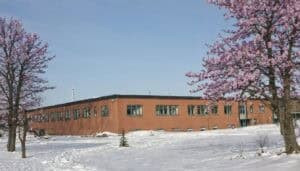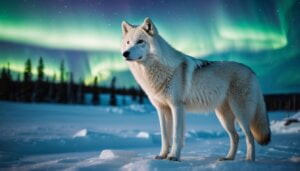Introduction
Arctic wolf conservation is a crucial aspect of preserving biodiversity in the Arctic region. Community programs play a significant role in these efforts, focusing on various aspects such as education, monitoring, and habitat protection
This article will explore the main goals and challenges of Arctic wolf conservation programs, delve into community involvement and educational initiatives, and examine how success is measured and funded
Join us as we uncover the vital work being done to protect these majestic creatures and their fragile ecosystem
Overview of Arctic Wolf Conservation Programs
Arctic wolf conservation programs are critical in ensuring the survival of this unique species and maintaining the delicate balance of the Arctic ecosystem. These programs are designed to address the specific needs and challenges faced by Arctic wolves, such as habitat loss, climate change, and human-wildlife conflict
In this section, we will discuss the main goals of Arctic wolf conservation, highlight some leading organizations involved in these efforts, and examine the challenges they encounter
Main Goals of Arctic Wolf Conservation
The primary goals of Arctic wolf conservation programs revolve around preserving the species and their natural habitat
These goals include:
Habitat Protection: Ensuring that the wolves’ natural habitats are preserved and protected from human encroachment and climate change. This involves designating protected areas and implementing policies that limit industrial activities such as mining and drilling in these regions
Population Monitoring: Regularly tracking the population size and health of Arctic wolves to identify trends and potential threats. This is often done through satellite tracking, camera traps, and field surveys
Reducing Human-Wildlife Conflict: Implementing strategies to minimize conflicts between Arctic wolves and human populations. This can include community education programs, developing non-lethal deterrents, and creating compensation schemes for livestock losses
Research and Data Collection: Conducting scientific research to better understand the ecology and behavior of Arctic wolves. This research helps inform conservation strategies and policy decisions
Public Awareness and Education: Raising awareness about the importance of Arctic wolves and the threats they face. Educational programs aim to foster a sense of stewardship among local communities and the general public
Leading Organizations in Arctic Wolf Conservation
Several organizations are at the forefront of Arctic wolf conservation, working tirelessly to protect this species and its habitat
Notable organizations include:
World Wildlife Fund (WWF): WWF engages in various projects aimed at conserving Arctic biodiversity, including Arctic wolves. They work on habitat preservation, climate change mitigation, and raising public awareness
Wildlife Conservation Society (WCS): WCS conducts extensive research and conservation programs across the Arctic region. Their work includes studying Arctic wolf populations, advocating for policy changes, and collaborating with local communities
Defenders of Wildlife: This organization focuses on protecting all wildlife and their habitats. They have specific programs targeting Arctic wolves, including initiatives to reduce human-wildlife conflict and promote coexistence strategies
Polar Bears International (PBI): While primarily focused on polar bears, PBI also addresses broader Arctic conservation issues that benefit Arctic wolves, such as climate change advocacy and habitat protection efforts
Challenges Faced by Arctic Wolf Conservation Programs
Arctic wolf conservation programs face several significant challenges, including:
Climate Change: The Arctic region is experiencing rapid warming, leading to habitat loss and changes in prey availability for Arctic wolves. Melting ice and altered landscapes threaten the wolves’ survival
Human Activities: Industrial activities such as oil and gas exploration, mining, and increased shipping traffic disrupt the wolves’ habitats and migration patterns. These activities also pose the risk of pollution and environmental degradation
Limited Funding: Conservation efforts often suffer from insufficient funding, which restricts the scope and effectiveness of programs. Securing sustainable financial resources is a constant challenge for organizations working in this field
Remote and Harsh Environment: The Arctic’s extreme conditions make conservation work logistically challenging and expensive. Researchers and conservationists must contend with harsh weather, difficult terrain, and limited accessibility
Political and Legal Hurdles: Implementing conservation measures requires navigating complex political and legal landscapes. Differences in policies and priorities among Arctic nations can hinder coordinated conservation efforts
These challenges underscore the importance of continued support and collaboration among conservation organizations, governments, and local communities to ensure the long-term survival of Arctic wolves
Community Involvement and Education
Community involvement and education are pivotal to the success of Arctic wolf conservation programs
Engaging local communities not only provides additional resources for monitoring and protecting wolves but also fosters a sense of stewardship and ownership over conservation efforts. Education initiatives help raise awareness and promote sustainable practices that benefit both the wolves and the communities
In this section, we will explore the various educational initiatives, participation and volunteer opportunities, and the critical role indigenous communities play in Arctic wolf conservation
Educational Initiatives in Arctic Wolf Conservation
Educational programs are designed to inform and engage both local communities and the broader public about the importance of Arctic wolves and the challenges they face
These initiatives include:
School Programs: Conservation organizations often collaborate with local schools to develop curricula that include lessons on Arctic ecology, the role of wolves in the ecosystem, and the impact of climate change. These programs aim to inspire the next generation of conservationists
Workshops and Seminars: Regular workshops and seminars are conducted to educate community members, policymakers, and other stakeholders. These events provide up-to-date information on conservation strategies, research findings, and ways to get involved
Public Awareness Campaigns: Utilizing social media, documentaries, and public events, conservation groups raise awareness about Arctic wolves. Campaigns focus on the wolves’ ecological significance and the urgent need for conservation measures
Citizen Science Programs: Citizen science initiatives encourage local residents and tourists to participate in data collection and monitoring efforts. This involvement not only aids researchers but also helps participants develop a deeper connection to the environment and conservation efforts
Participation and Volunteer Opportunities for Local Communities
Local communities play a crucial role in the success of Arctic wolf conservation programs
Opportunities for participation and volunteer work include:
Monitoring Programs: Community members are trained to help monitor wolf populations and their habitats. This includes tracking movements, collecting scat samples, and setting up camera traps. Their contributions provide valuable data for conservationists
Habitat Restoration Projects: Volunteers can participate in projects aimed at restoring and preserving wolf habitats. This might involve planting native vegetation, cleaning up polluted areas, and building protective barriers
Advocacy and Outreach: Community members can join advocacy groups to promote conservation policies and practices. This includes participating in public meetings, writing to policymakers, and spreading awareness within their networks
Ecotourism Initiatives: By promoting responsible ecotourism, local communities can generate income while protecting Arctic wolf habitats. Tour guides educate visitors about conservation efforts and the importance of preserving the natural environment
Role of Indigenous Communities
Indigenous communities in the Arctic have a profound connection to the land and its wildlife, including Arctic wolves. Their involvement in conservation programs is vital due to their traditional knowledge and sustainable practices
Key aspects of their role include:
Traditional Knowledge: Indigenous knowledge about Arctic wolves’ behavior, migration patterns, and habitat use is invaluable. This information often complements scientific research and helps develop more effective conservation strategies
Cultural Significance: Arctic wolves hold cultural significance for many indigenous communities. Conservation programs that incorporate indigenous values and perspectives are more likely to be successful and receive community support
Co-Management Agreements: Many conservation programs involve co-management agreements where indigenous communities share decision-making power with government and conservation organizations. This collaborative approach ensures that conservation measures respect indigenous rights and priorities
Sustainable Practices: Indigenous communities have long practiced sustainable ways of living that can serve as models for conservation efforts. By integrating these practices, conservation programs can promote sustainability while preserving cultural heritage
Community involvement and education are essential components of Arctic wolf conservation, providing the necessary support, knowledge, and resources to protect this species and its habitat. By engaging local and indigenous communities, conservation efforts become more inclusive, effective, and sustainable
Measuring Success and Funding
Evaluating the effectiveness of conservation programs and securing sufficient funding are critical components in the effort to protect Arctic wolves. Successful conservation programs rely on accurate data collection, thorough analysis, and adequate financial resources to implement and sustain their activities
This section will discuss the methods used to measure the success of Arctic wolf conservation programs, the various sources of funding, and how these elements contribute to the overall effectiveness of conservation efforts
Measuring the Success of Conservation Programs
To ensure the effectiveness of conservation programs, it is essential to have robust methods for measuring success
These methods include:
Population Surveys: Regular population surveys help track the number of Arctic wolves in specific areas over time. Techniques such as aerial surveys, camera traps, and GPS collars are commonly used to monitor wolf populations and their movements
Health Assessments: Monitoring the health of wolf populations is crucial. This involves collecting and analyzing samples such as blood, fur, and scat to detect diseases, parasites, and overall health conditions. Healthy wolf populations indicate successful conservation efforts
Habitat Quality: Evaluating the quality and availability of habitats is essential for understanding the wolves’ living conditions. This includes assessing prey availability, vegetation cover, and the impact of human activities on the habitat
Human-Wildlife Conflict Incidents: Tracking and analyzing incidents of human-wildlife conflict, such as livestock predation, helps measure the effectiveness of conflict mitigation strategies. A decrease in such incidents often reflects successful community engagement and conservation practices
Genetic Diversity: Maintaining genetic diversity is vital for the long-term survival of Arctic wolves. Genetic studies help monitor inbreeding levels and genetic variation within populations, which are indicators of a healthy and resilient population
Funding Sources for Arctic Wolf Conservation
Adequate funding is necessary to support the wide range of activities involved in Arctic wolf conservation
Funding sources include:
Government Grants: Many conservation programs receive funding from government grants dedicated to wildlife protection and environmental preservation. These grants often support research, habitat protection, and public education initiatives
Non-Profit Organizations: Non-profit organizations like the WWF, WCS, and Defenders of Wildlife play a significant role in funding conservation efforts. They provide financial resources for fieldwork, research, and community programs through donations and fundraising campaigns
Corporate Sponsorships: Some corporations sponsor conservation programs as part of their corporate social responsibility initiatives. These sponsorships can provide substantial financial support and help raise awareness about conservation issues
Crowdfunding and Donations: Crowdfunding platforms and direct donations from individuals are increasingly popular sources of funding. These contributions, although often smaller in amount, collectively provide significant support for various conservation activities
International Aid and Collaboration: International organizations and collaborations, such as the United Nations Environment Programme (UNEP) and the Arctic Council, also provide funding and support for Arctic wolf conservation. These collaborations often focus on large-scale projects and cross-border initiatives
Securing sustainable funding and effectively measuring the success of conservation programs are critical to the long-term protection of Arctic wolves
By employing comprehensive evaluation methods and diversifying funding sources, conservationists can ensure that their efforts are both effective and sustainable, ultimately contributing to the preservation of Arctic wolves and their habitat
Conclusion
Arctic wolf conservation programs are essential for safeguarding this unique species and the fragile ecosystems they inhabit. These efforts involve a multi-faceted approach that includes habitat protection, population monitoring, research, public education, and community involvement
Leading organizations such as the WWF, WCS, and Defenders of Wildlife play pivotal roles in advancing these goals despite numerous challenges, including climate change, human activities, and limited funding
Community involvement and education are crucial, empowering local and indigenous communities to participate actively in conservation efforts. Educational initiatives raise awareness and inspire action, while volunteer opportunities and citizen science programs provide valuable data and foster a sense of stewardship
Measuring the success of these programs through population surveys, health assessments, and habitat quality evaluations ensures that conservation strategies are effective and adaptive. Securing diverse funding sources, from government grants to crowdfunding, is vital for the sustained implementation of these programs
Through collaborative efforts, continuous monitoring, and robust funding, Arctic wolf conservation programs can achieve their goals, ensuring the long-term survival of Arctic wolves and the health of their ecosystems
By addressing the unique challenges they face and engaging communities at every level, these programs contribute significantly to preserving the natural heritage of the Arctic region


